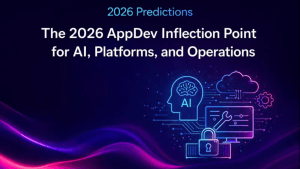Premise. High-value traditional applications (HVTA) still constitute 40%-50% of IT spending in large organizations in the form of maintenance or enhancement costs. Any serious digital transformation and cloud strategy must provide a path for modernizing these applications.
Any investment in technology to support digital transformation should consider two issues: (1) how does the investment create brand new digital capabilities; and (2) how does the investment modernize and improve the value of existing capabilities, in a digital context. Too often we focus on the former, not recognizing the essential contributions of the latter.
However, CIOs have to consider both classes of the value stream. Why? First, and obviously, because the practical reality is that in 95%+ of large enterprises the “existing capabilities,” supported by high-value traditional applications (HVTA), are essential to competent business operations. Second, but less obvious, because unlocking new value streams from HVTAs will become a crucial source of competitive advantage.
A look at technical debt may help explain this second point. Wikibon estimates that technical debt – the opportunity cost of lost strategic options because of past technology choices – exceeds $1.7 trillion and is growing (during this period of significant transformation) at 8%-10% per annum. To put that figure in context, 2018 technical debt is about 113% of tech spending and growing twice as fast. In a digital economy, the enterprises that reduce technical debt the fastest will tend to win against traditional players and be best positioned to respond to digital natives.
The good news for enterprises is that the cloud is on the critical path for any and all efforts to digitally transform. Every enterprise should endeavor to evolve to a multicloud operating model (MOM) capable of sustaining and improving the profitability of existing operations while creating new business options. However, different enterprises will take different routes, based on market, brand, technical, and other resource-based considerations. Wikibon has identified four paths to alleviating technical debt. One, adding cloud capabilities to platforms, is especially relevant for HVTAs. In effect, this involves undergirding applications with hardware that is imbued with cloud-like services. Essentially, this is like keeping the application in place in your data center or hosting facility and “migrating the hardware.” For essential applications that can’t be moved to a public cloud (because of technical issues), shouldn’t be moved to a public cloud (because of financial or regulatory considerations), or are too expensive to re-write for native public cloud deployment, this is the best modernization path.
After years of fighting the cloud, system vendors are accelerating efforts to add cloud capabilities to their hardware platforms. The result is that enterprises can start making important investments to:
- Bring HVTAs under the umbrella of a modern MOM to improve resource utilization and automation.
- Ensure that data from HVTAs can be leveraged in newer business-differentiating systems.
- Enhance the longer-term business value of HVTAs through cloud-native services.
- Dramatically simplify the administration of lifecycle activities for HVTA workloads (e.g., SAP/HANA, Oracle, SQL Server) by consolidating development, test, analytics, and production systems.
The ability to consolidate application lifecycle workloads and activities is especially important as enterprises modernize HVTAs with cloud-like experiences. Typically, shops have had to sustain multiple, largely distinct infrastructure for development, test, production, and analytics workloads. Maintaining four separate complexes for single applications generated 2-4 times the hardware and software costs, doubled administration costs, and roughly tripled the likelihood of system failure somewhere in the lifecycle due to human error. Moreover, while each set of application lifecycle processes is different enough to require specific modernization treatment, in most shops one or another of dev, test, production, and analytics typically received up-to-date investment, while others languished on older, more brittle resources. Consolidating workloads on modern technology reduces the cost and technical debt associated with all lifecycle workloads.
Wikibon recently reviewed the VxBlock 1000 with its VxBlock Central software as an example of an enterprise hardware platform that is being enhanced specifically to bring the cloud operations experience to HVTAs. The VxBlock 1000 is a converged infrastructure (CI) platform that is designed to consolidate high-value traditional applications (HVTAs), the technology to bridge HVTAs to MOMs, and is friendly to HVTA administrators, especially when integrated with VMware’s vRealize via optional plug-ins and management packs (see Table 1).
| Multi-Cloud Operating Model for High-Value Traditional Application (HVTA) Criteria | VxBlock 1000 Capabilities |
| Multicloud Operating Model Support | |
| Rapid build and test data-first software | Dev/Test workloads can be consolidated on the same converged infrastructure as operational HVTAs. Snapshots of data provide “live” test data, which can dramatically accelerate development cycles, bringing HVTA maintenance and enhancement work closer to Agile-like methods.
Documented application development life cycles to be accelerated by 34% and new applications deployed per year to be increased by 33%. |
| Automated deployments | Time to perform important system administration tasks can be reduced by 90% using tightly integrated VxBlock Central software’s automated workflows in combination with VMware vRealize Orchestrator. Examples include system expansion and infrastructure service configuration.
While not as simple as the infrastructure-as-a-service in a public cloud, customers can use the VMware vRealize software on VxBlock 1000 to create their own workflows and cloud services blueprints for self-service. Release Certification Matrix (RCM) continuously validates interoperability and compatibility of infrastructure elements, including key system software resources throughout the system lifecycle. Application deployment times have been documented to be reduced by 34%. |
| APIs as consumable services | Nothing at the application service, per se, but important improvements at the system and virtualization level.
Integrated analytics and awareness tooling from VxBlock Central software’s dashboard improves system visibility and reporting of application scalability requirements. Key management resources provided as VxBlock Central APIs to VMware vRealize Operations dashboards via a management pack and for 3rd-parties to leverage with other management tools. |
| Simplified and more common operations | Consolidation of dozens of tools into a common set of physical resource management tools (VxBlock Central) and virtual machine managers (VMware vRealize). Integration between these sets provides unified management of virtual resources and their underlying physical infrastructure.
Not as simple as “no-ops” public cloud services, but dramatically reduces administrative complexity, which leads to documented improvements like 99% reduction in unplanned downtime, 66% more efficient operations, and greater than 60% reduction in operations costs. |
| Data-first control | Architected inventory, health, and lifecycle management data models that feed all awareness and automation management components, including VMware vRealize dashboards. |
| Provide True Private Cloud Utilization | |
| Usage-based pricing | Not supported in Dell EMC’s “Pay-As-You-Grow” financing programs but can be included in a “Data Center Utility” agreement for very large purchases. |
| Tightly integrated virtualization options | Industry’s deepest integration between three-tiered converged infrastructure (compute, storage and network) and VMware. |
| Single vendor responsibility | Technology from Dell EMC, Cisco, and VMware combined and supported by Dell EMC help desk services and field support.
Dell EMC Release Certification Matrix (RCM) process continuously validates interoperability and compatibility of infrastructure elements, including virtualization and management software resources. |
| Robust orchestration of system | VxBlock Central integrated with VxBlock 1000 to provide integrated service monitoring, administration experience, and service delivery automation.
Today, VxBlock Central orchestration capabilities are focused on infrastructure resource provisioning and expansion. Tightly integrated with VMware vRealize tooling like Automation, Orchestrator, Operations, and Business Cloud to provide rich virtual machine services on an extremely scalable platform. |
| Rolling maintenance and in-place upgrades by vendor | VxBlock Central performs daily assessments of VxBlock hardware and software components and alerts users of technical and security issues that require firmware and system software upgrades and patches – and downloads them for installation. These can be installed by users or Dell EMC professional services in-place by following guided procedures that avoid production workload interruption.
Previously, hardware expansion (installation and configuration) required Dell EMC professional services. With the growing library of automated workflows that Dell EMC is building for VMware vRealize Orchestrator, users can reduce manual administration or their reliance on Dell EMC Professional Services to expand and configure the VxBlock in-place. Documented 6X reduction in time to upgrade the entire infrastructure stack. |
| Scalable family of system options | VxBlock 1000 resources can support more than 1,000 physical servers and more than 100 petabytes of storage, each with a broad range of optional features and independently scaled to meet each HVTA’s unique requirements for a true private cloud experience.
Part of Dell EMC’s infrastructure product portfolio, which increasingly uses common system elements, including VMware, to provide true private cloud experiences. Scalable system architecture documented to support multiple workloads with application performance improved by 29%, execution of business transactions increased by 30% and time to run analytical queries reduced by 29%. |
| Simplified Vendor Packaging | |
| Multicloud data protection services | Strong integration with Dell EMC’s well-regarded data protection suite of hardware appliances, storage-array embedded features and software, that include back-up, replication with selectable recovery time and recovery-point objective, and continuous replication for business continuity.
Automated data protection back-up and replication services can be implemented locally, across remote sites and with public clouds. |
| Multicloud management services | As part of the Dell Technologies Cloud portfolio, VxBlock 1000 supports VMware software and other Dell EMC infrastructure products and more than 4,200 public cloud providers, including AWS, Microsoft Azure and Google Cloud Platform, for consistent multi-cloud management and workload mobility. |
| Intercloud networking functions | VxBlock 1000 supports VMware NSX software defined networking, the foundation for VMware-based inter-cloud networking. |
| Documented and bonded multivendor packaging | Mature partnership between Dell EMC, Cisco, and VMware brings leadership compute, networking, storage, data protection and virtualization technology into a simple yet extremely flexible package.
The VxBlock 1000 architecture enables the addition of new technologies into the system, such as next-generation servers for in-memory databases and new NVMe protocol-based storage, server and network technologies for very high-performance end-to-end services. Release Certification Matrix (RCM) continuously validates interoperability and compatibility of infrastructure elements and key system software resources, including new technology options as they are introduced. |
Table 1. How Does VxBlock 1000 with VxBlock Central Stack Up Against MOM Requirements?
VxBlock 1000 is a serious machine, the product of a 10-year partnership between Dell EMC and Cisco. It was one of the earliest examples of a CI system and remains one of the most successful for HVTAs. The VxBlock – designed with a high scale/high performance and fault-tolerant architecture with native data protection – is proven for HVTAs in nearly 5,000 installations over 10 years. With the new VxBlock 1000’s design to perpetually accept new technologies, customers have the opportunity to consolidate HVTAs on a system that can side-step the inevitable technical debt of older-generation IT choices.
With cloud on the critical path to digital transformation, the VxBlock enables organizations to keep their HVTAs in place and modernize with cloud-enabled hardware underneath. IT shops can consolidate their HVTAs’ multiple, largely-distinct infrastructure for development, test, production, and analytics workloads on VxBlock, get the benefits of a multi-cloud operations model (MOM), and be in a better position to migrate HVTA data capital to new-generation databases and applications all on one system. Perhaps there’s no more compelling examples than undergirding legacy SAP, Oracle and SQL with VxBlock and migrating that data to newer versions before they reach end-of-life and leveraging the data capital for analytics and new high value applications.
Action Item. No digital business strategy is complete without an IT cloud strategy, and no IT cloud strategy is complete without a plan to modernize high value traditional applications (HVTAs). Traditional hardware vendors finally are embracing the cloud in meaningful ways. Any enterprise cloud strategy must consider true private cloud infrastructure solutions that advance multicloud operating model experiences for HVTA apps. A leading example? Dell EMC’s VxBlock 1000 with VxBlock Central.


